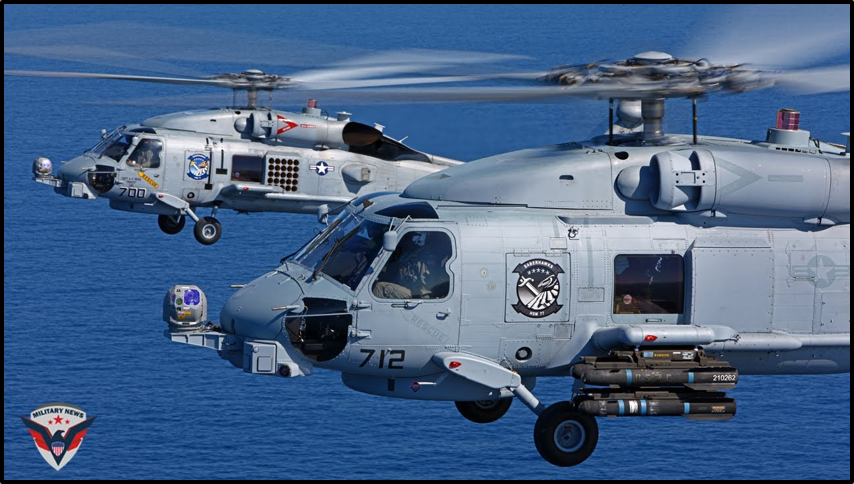Table of Contents


ANTI SUBMARINE WARFARE (EASY MODE)
Anti-submarine Warfare (or ASW for short) is a type of Naval warfare that involves a large variety of military disciplines centered around countering the venerable submarine. Fixed wing, rotary wing, surface vessels, and of course submarines all come together as players in this game of cat and mouse at sea. Submarines have been used by humans to sneak around and sink ships since the civil war. They started having a key role in naval warfare with the first world war, and have only improved since then. Modern submarines are quieter, harder to find, and extremely deadly. Carried out by all of the previously mentioned assets, ASW is the only way to counter a submarine attack without another submarine. The different groups work together using sonar devices, underwater microphones, magnetic sensors, torpedoes, and a whole lot of coordination to find and destroy the enemy submarine lurking beneath the waves.
SUBMARINES IN DCS
Out of the box, the DCS submarines are primitive and simple. There is no simulation of SONAR, sound, or even a torpedo that can track targets. To make ASW interesting, the AI behaviour, underwater sound physics, and tracking torpedoes all must be handled by scripts. There are no sonobuoys or SONAR probes in DCS either so those must also be simulated.

SCRIPTED AI
The ASW script handles the behavior of the submarines. These are some of the situations where the script will make decisions for the submarine:
CONDUCTING ASW IN DCS
The mission may not look like much on the surface, but it is alive and dynamic under the waves. You will be fully involved as you bounce around trying to identify the position of the submarine, all while it works to evade you. It may take 20 minutes, or up to a couple hours to conduct the search. Factors include your ability to hover over water, your strategy in the search, how lucky you are, and how many friends you have helping you. The script provides you with all the tools you need to find, fix, and destroy an enemy submarine hiding under water:

- Sonobuoy: This small device is ejected or dropped from the helicopter and parachutes to the surface. It is essentially an underwater directional microphone
- SONAR Dipping probe: This is a winch controlled device built into your helicopter. It extends and retracts from the belly and is submerged under water to listen and emit an active SONAR pulse
- Mk46 Torpedo: Aircraft equipped with the Mk46 Torpedo can drop them into the water. Once in the water, they will have simulated tracking and impact, inflicting actual damage to the target submarine

To operate the ASW system in DCS, you must be in an ASW enabled helicopter. These are typically the ones with “ASW” in their name. Upon entering the aircraft, you should be prompted with a welcome message. This is how you know it is operational.
Open your Radio Menu and go to F10 (Other). You will find the option ASW CONTROLLER in here. This sub-menu (no pun intended) will have all the controls you need to operate the ASW system in your aircraft.
You will need to monitor your F10 map frequently as this is the only way to see activity on the Sonobuoy sensors.
There will also be various sounds played for feedback of the system. You will hear sounds of the winch, SONAR ping, Sonobuoy deployment, as well as several voice lines recorded by [BSD]RePhil acting as the ASW operator in the back of your helicopter.
SONOBUOY
The first thing to do in ASW is start dropping these in the water. They will provide you with a large detection area and if the submarine doesn’t hear them, a rough direction of the target:

| Max Range: 15 km | Battery Life: 60 min | |
| Speed Silent: <1 kt | Speed Quiet: 1-2 kt | Speed Loud: 2-15 kt |
SONAR PROBE
Once you have a good idea of where the target is, you can start using your SONAR Dip Probe to get an accurate position of the target. To begin, you must first lower the probe into the water:
- ‘Arm’ the probe sequence by hitting the radio menu item ‘Prepare SONAR Probe’
- Come to a stable hover at or below 40’ or 12m ASL
- The probe will begin to deploy after 5 seconds of stability. It takes 30 seconds to deploy fully
Do not move after the probe starts to deploy. It will take damage and become inoperable after too much damage is done!
When you want to recover the probe, slowly gain altitude. Once the probe is no longer submerged, it will retract back into the aircraft. You are free to move around once it starts retracting. When the probe is deployed, it will begin to emit SONAR pings and try to identify a target. If there is a submarine within range of the probe and it is not in a shadow zone, you will receive details of the target. The target heading will be dead accurate, however the range may be skewed by the non-linear and non-constant speed of sound under water. The closer you are to the target, the more accurate it will be.

The probe is set to automatically repeat pings after 30 seconds. You can change this in the settings. You can also manually trigger the SONAR pulse. In the radio menu, select MANUAL PING NOW when the probe is fully deployed
- Max Range: 5km
- Shadow Zones: None in Easy mode
- Distance Inaccuracy: +-2km
When a submarine receives an active SONAR pulse, it will begin to make evasive maneuvers to defeat you. The submarine will either turn to the nearest shadow zone, or turn away from you to escape your range. The submarine will travel at ¾ speed to get away, while still being able to hear. You will see it on your sonobuoys when this happens. It is recommended that you repeat sonar pings at least two more times to get an idea of where the sub is evading to.
Upon reaching its destination, the sub will slow down to near-silent speed and continue with its tasking.

MK46 TORPEDO USAGE
When you are certain you have the submarine narrowed down to a nearly precise location, it's time to deploy weapons on it. If your aircraft is equipped with torpedos, the ASW script will simulate the event:
- Turn toward the target as accurately as you can and drop a torpedo like it's a bomb.
- Your ASW operator will inform you if there's a positive track or not and will report the time of impact.
- There's a chance the target will defeat the torpedo through countermeasures and evasive maneuvers.
- If undefeated, the torpedo will hit the target and inflict damage. Your ASW operator will report this and you should see a splash
- If the sub is destroyed, you may see bodies in the water. If not, the submarine will surface and can be destroyed.

| Max Range: 5 km | Shadow zones: none | Max Azimuth: +/-45 deg |
| Max Speed: 83 kt | Max Depth: 900' | Hit Chance: 95% |